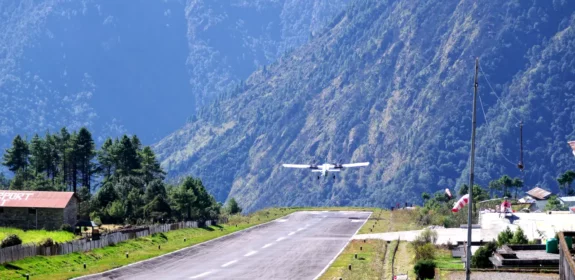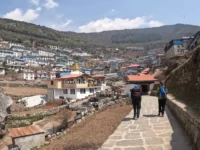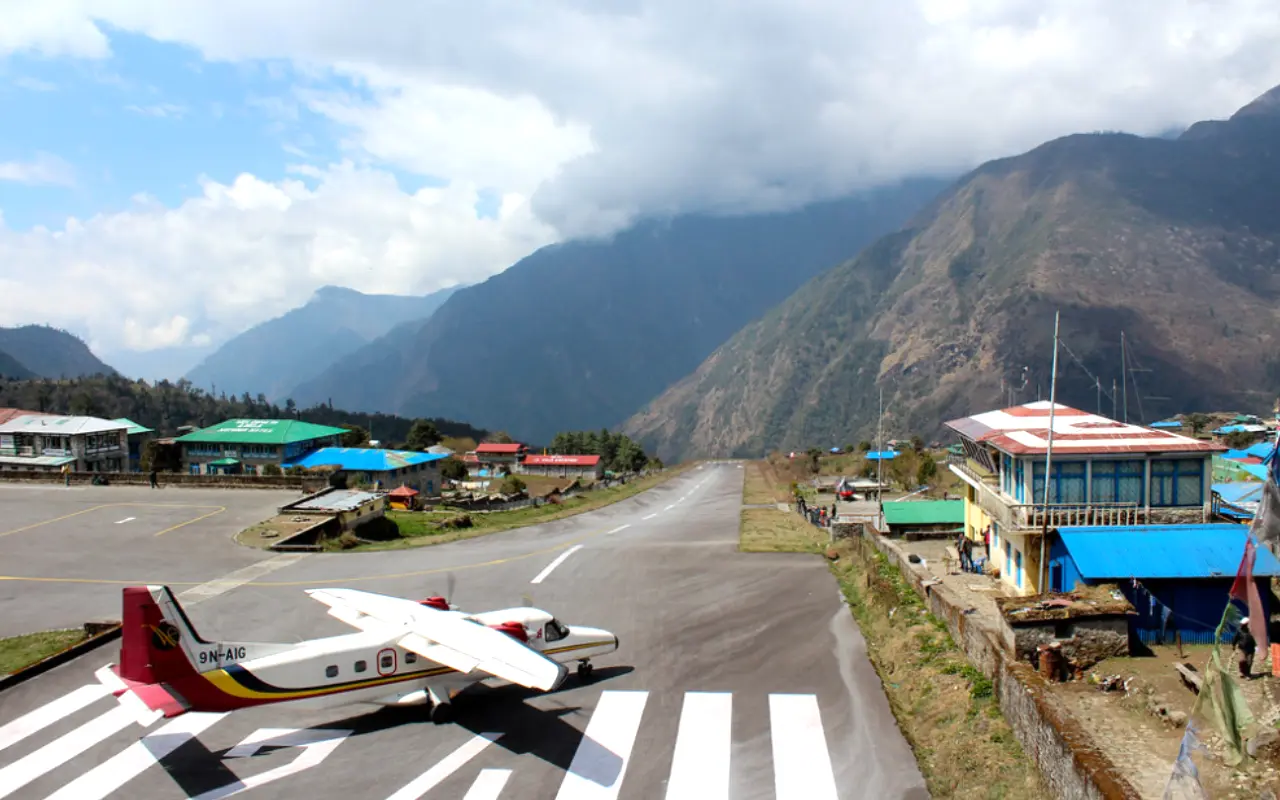
For people having queries, “Where is Lukla Airport”? The answer is that the airport is located in Lukla town at an elevation of 2,845 meters in Solukhumbu District, Nepal. For travelers wishing to ascend the high alpine region of the Everest region, it is the main access point.
Lukla Airport is also known as Tenzing-Hillary Airport, and it is the main starting point of many treks in the Everest region, including the famous Everest Base Camp Trek. This airport is significant as it saves adventurers days of hiking into this area via the short 30-40 minute flight experience in Kathmandu.
Lukla Airport has a great contribution to the local economy as it boosts the tourism industry by providing transportation, local supplies, and needed emergency evacuations. It maintains trekking, lodging, and guiding services, as well as the general welfare of people in the whole region of Everest.
Lukla Airport is infamous and one of the feared airports because of its very short and steep inclination runway established on mountainous terrain with highly fickle weather. This contributes to landing and takeoff being extremely hazardous, such that it has earned a status of being the most dangerous airport in the world.
Where is Lukla Airport?
Tenzing-Hillary Airport, also called Lukla Airport, is situated in Nepal’s Khumbu area in the Solukhumbu district. It is a required entry point to trekkers heading towards the Everest region, and it finds itself set on rugged Himalayan terrain.
The airport is located at around 2845 meters (9,334 feet) above sea level. This altitude is what makes it one of the highest airports in the world, and has a bearing on both the pilot and the adventurer in departing or entering the airport.
For the question, “Where is Lukla Airport topographically?” it is found in the middle of high mountains and deep gorges. It lies cut into the mountainside, leaving surrounding views of breathtaking natural vistas for miles, which complicate and allow for the best natural air environment flying out of and into the airport, keeping it a fabulous yet treacherous entry to Everest.
Just to note, Lukla Airport is roughly 138 kilometers (86 miles) by air from Kathmandu, and the flight lasts between 30-35 minutes. This 35-minute flight can save you days of trekking through varied mountains and environments before you get to Lukla.
The Role of Lukla Airport in Everest Treks
Lukla Airport is the main access point to Everest Base Camp and to the Khumbu region of Nepal. There is a fast flight from Kathmandu to Lukla that saves trekkers days of hiking up through the mountains, so it is obligatory for an Everest endeavor.
You can reach Everest Base Camp via a trek from Jiri or Phaplu, but this route takes many additional days and is also physically more demanding. These routes are less frequented because it takes much longer to reach Everest and because they are physically challenging trekking routes that do not offer the option of air transport.
There are about 20 to 30 flights per day in peak trekking seasons, and a year, it serves about 30,000 trekking customers. The majority of flights are made in the morning as weather conditions are at their best, yet it is usual that delays happen under the influence of fog and clouds.
Lukla Airport is crucial to tourism and safety in the region, since it has a short and steep landing strip providing easier access to Everest, as well as the ability to evacuate. The flight operators ensure the safety records of their flights under adverse flying conditions.
Why is Lukla Airport Called the World’s Most Dangerous Airport?
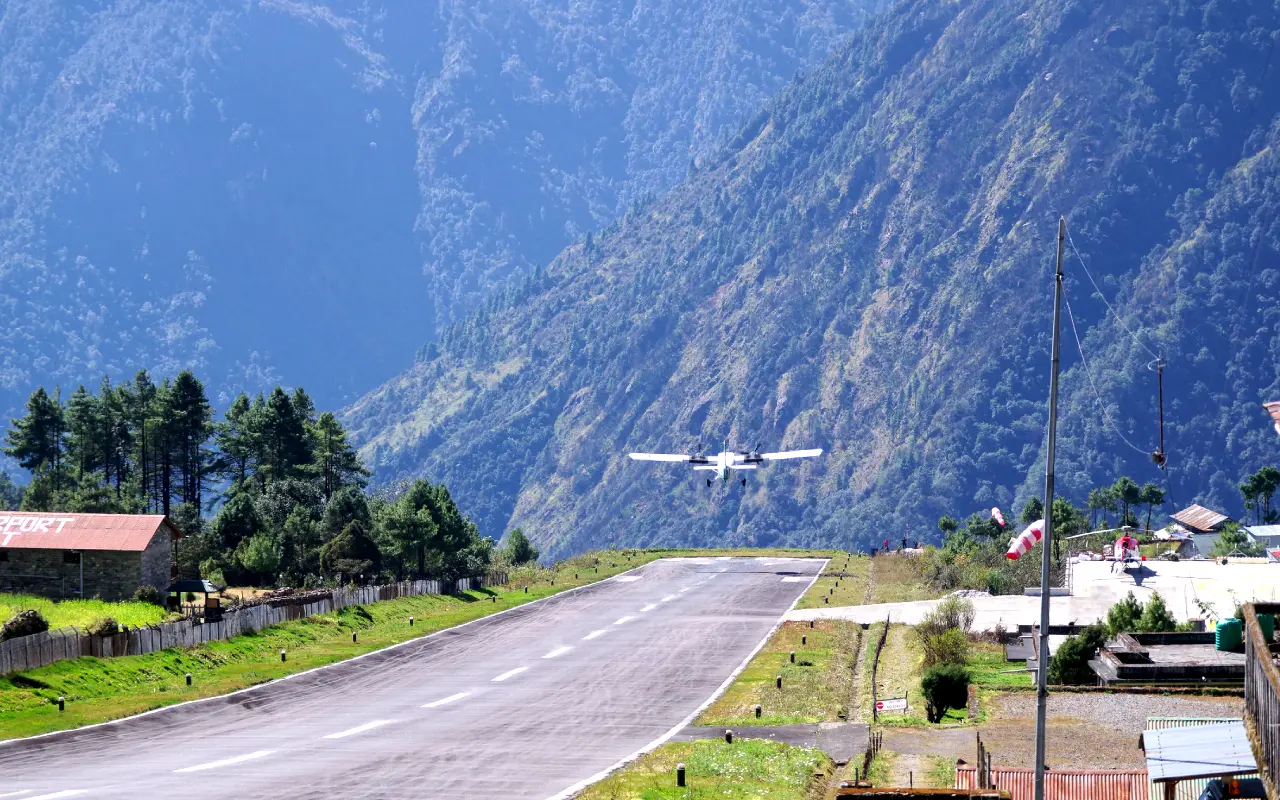
• Short Runway
The runway in the Lukla Airport is very small, having a length of approximately 527 meters (1,729 feet). It is a short distance that can give very little opportunity to either speed up so that the airplanes can take off or slow down when landing, so it requires good pilot control measures.
It has a distinctive slope on the runway, which has an about 12 percent gradient, which helps in downhill takeoffs and uphill landings. This slope serves to accelerate or decelerate aircraft in a short time, but it needs professional skills due to the short available runway. The short runway, steep grade, and mountainous environment will only leave a narrow margin of error.
• Mountainous Terrain
Lukla Airport, in the Khumbu region of Nepal, is surrounded by such tall Himalayan mountains that constrain the options of the flight paths taken by aircraft. Pilots have the responsibility of avoiding making any mistakes or going through very narrow valleys and ridges to get in or out.
The fact that the airport is located in a deep valley area close to the entrance to the Everest region implies that there are not too many options when it comes to entering or exiting the airspace. Such a difficult terrain makes flight more complicated and requires very experienced pilots who are well-trained in mountain flying situations.
• Unpredictable Weather
Severe fog, high winds, and dense clouds may form without due warning and thus may necessitate flight delays or cancellations as a precautionary measure on behalf of the passengers.
Such weather issues imply that flight operations usually take place only during the early mornings when the weather is more predictable. Nevertheless, the sudden weather variations in Lukla pose a high level of uncertainty very high on its schedules, necessitating the need for flexible planning among travelers.
• High Altitude Challenges
Thin air at a high altitude of nearly 2,845 meters at Lukla has an influence on the aircraft in its performance by increasing the amount of runway and lessening the engine. The effect on take-off and landing efficiency further poses risks during flight operations.
Also, Lukla airport lacks the possibility of a go-around in case the attempt to land fails, as there are mountains around it. The pilots are obliged to land on the first approach because there is no safe way to abort and attempt again.
Safety Records and Improvements
For people’s queries about “Where is Lukla Airport and how safe have been the records of this airport? In the past 23 years, Lukla Airport has recorded only five accidents, with just one fatal commercial incident since 2008, resulting in over 18 fatalities in total. This depicts the enhancements in safety in the course of time.
Measures implemented to enhance safety at Lukla airport include the strict cancellation of flights when people witness bad weather. Advanced real-time observation of weather patterns, lighting up the runway, and baggage restrictions are additional measures implemented to minimize of risks of challenging high altitude airports.
Experienced pilots who are highly familiar with the layout of Lukla Airport also require the strictest standards of aviation in Nepal, as they need to perform a large number of supervised landings and extensive use of a simulator. Such knowledge helps in guaranteeing the safety of operation despite the short, sloped runway and unreliable weather of the airport.
Visual flight rules limiting flights only to clear, thinkable mornings, regular safety audits, and installation of new baggage screening technology, etc., come under regulatory measures. All these measures bring about more safety, which is both important and needed to accommodate the numerous trekkers who use the gateway to Everest.
What to Expect When Flying to Lukla
The aircraft used in Kathmandu Lukla flights are small STOL aircraft, mainly De Havilland Canada DHC-6 Twin Otter, Let L-410 Turbolet, and Dornier Do 228. The planes are customized regarding their short takeoff and landing on the Lukla runway, which is also a difficult runway.
It will take 30 to 40 minutes to reach Lukla on a flight from Kathmandu. The passengers are driven through the beautiful mountainous scenes, and they are able to observe the Himalaya mountain ranges and deep valleys. This trip could be quite exciting because of the uniqueness of the approach and terrain of the airport.
Passengers generally seated in these planes are 14-19, and arrangements of the seats are, in common cases, two rows a side of the plane with good views of the window. It is smaller, hence more intimate, but also a bumpy flight experience.
To see the grandeur, passengers are informed to reserve the seats in advance, earlier in the morning when the weather is sunnier, and purchase the left side windows, which offer the best scenery. It is advised to book with certified airlines that operate STOL aircraft to be safe.
Tips for a Safe and Smooth Lukla Flight
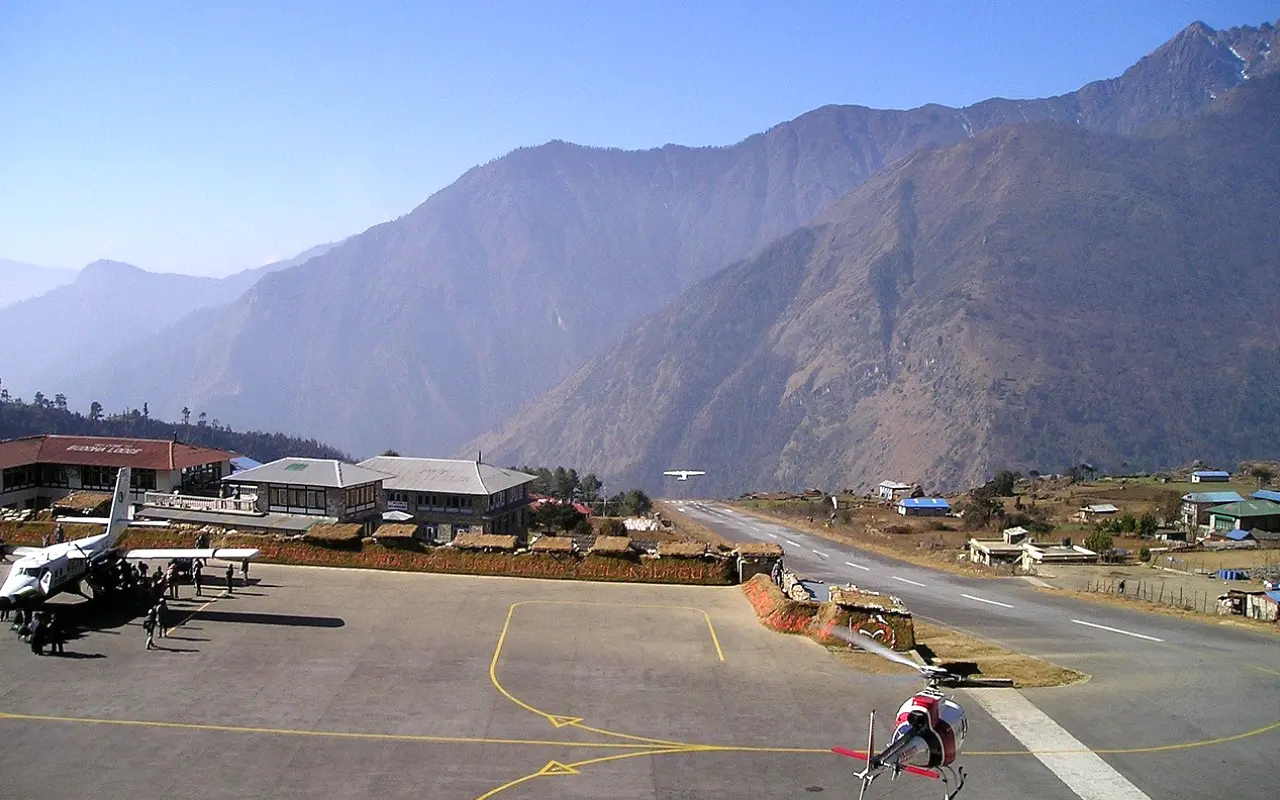
Months of Late February to May and Late September to November are the best times to enjoy the Lukla flight from Kathmandu. These Months provide the best weather conditions; it is clear and dry, hence no flights are canceled, and takeoff and landing will be safer.
It is favorable to fly early in the morning to Lukla because most time, weather conditions are clearer and more stable at this time of the day. The presence of fog, wind, and cloud cover is at a greater risk in the afternoon flights, which may lead to long delays and cancellations.
A smart idea would be to put buffer days in Kathmandu prior to and after your Lukla flight. The weather is also unpredictable, which is likely to bring you some delays; hence, additional days will give more time flexibility on the itinerary without interfering with the trekking activities or the connecting flights.
In deciding on an airline to select, use reputable companies with skilled pilots who are specifically trained to navigate the challenging terrain of Lukla. More established airlines would have a better maintenance system, safer records, and a clearer signal of the aviation status and weather.
Traveling in the morning flights and sitting at the window seat on the left-hand side is safer and also provides scenic beauty during peak-season trekking. Weather updates need to be checked always, flights have to be confirmed a day before, and rapid changes have to be expected due to climatic changes in this mountain path.
Conclusion
In summary, for the question “Where is Lukla Airport?” Lukla Airport is nestled in Nepal’s Khumbu region at 2,845 meters. This Airport presents exceptional but tough circumstances of a short and inclined runway, bordered by mountain bodies and unstable weather patterns, with the combination giving Lukla Airport unusual and hard conditions of access to Everest.
Although Lukla Airport presents severe risks, owing to weather conditions, the altitude, and the small runway length, it is critical to the accessibility process of trekking. These issues are supported by its reputation as the most dangerous airport in the world, which is balanced by extraordinary safety precautions and training of the pilots.
Adventurers need to embrace the flight to Lukla Airport as part of their Everest journey. The daring trip in the beautiful landscapes of the Himalayas, though risky, makes the experience complete and makes adventurers ready to enjoy the wonders of trekking that await them on the other side.

